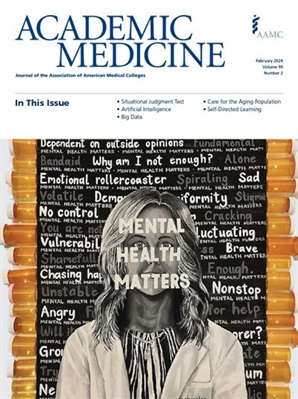First-Generation Low-Income Individuals in Medicine: A Scoping Review.
IF 5.3
2区 教育学
Q1 EDUCATION, SCIENTIFIC DISCIPLINES
引用次数: 0
Abstract
PURPOSE This comprehensive scoping review of the medical literature on first-generation low-income (FGLI) individuals in medicine aimed to synthesize the highest levels of evidence to inform medical education stakeholders. METHOD Database searches were conducted in Academic Search Premier, Education Research Premier, ERIC, Ovid MEDLINE, Ovid Embase, Professional Development Collection, PubMed, Scopus, Google Scholar, and Web of Science Core Collection from database inception through March 15, 2023. English-language articles on first-generation or low-income individuals in medicine from U.S. medical schools were included. Articles were evaluated for level of evidence and themes chosen. RESULTS Database searches resulted in 27,075 citations, 247 of which qualified for data extraction. The articles were classified by evidence level: level I (n = 2), level II (n = 17), level III (n = 90), level IV (n = 78), and level V (n = 60). Publications reported on 9 major outcomes: exam performance (n = 108), medical school performance (n = 63), residency and fellowship performance (n = 7), honor society status (n = 12), leave of absence (n = 9), withdrawal, dismissal, and attrition (n = 20), medical education graduation (n = 37), career choice (n = 109), and intent to practice in disadvantaged and rural communities (n = 60). Compared with their peers, FGLI individuals had lower medical school and standardized exam scores, enrollment in national medical honor societies and multiple degree programs, and graduate medical education performance and higher rates of leaves of absence, incompletion of medical education, pursuing primary care and family medicine specialties, and intent to practice in underserved communities. CONCLUSIONS Despite an increase in the number of FGLI individuals in medicine, there remains significant opportunity to improve their inclusion and support. Multi-institutional, prospective, risk-adjusted, observational studies are required to determine how to best support FGLI individuals through all medical career stages.医学界的第一代低收入者:范围审查。
目的本综述对医学界第一代低收入者(FGLI)的医学文献进行了全面的范围界定,旨在综合最高水平的证据,为医学教育相关人员提供信息。方法从数据库建立到 2023 年 3 月 15 日,在 Academic Search Premier、Education Research Premier、ERIC、Ovid MEDLINE、Ovid Embase、Professional Development Collection、PubMed、Scopus、Google Scholar 和 Web of Science Core Collection 中进行了数据库检索。收录了美国医学院中有关第一代或低收入从医者的英文文章。对文章进行了证据等级评估,并选定了主题。结果数据库搜索共获得 27,075 条引文,其中 247 条符合数据提取条件。文章按证据等级分类:I 级(n = 2)、II 级(n = 17)、III 级(n = 90)、IV 级(n = 78)和 V 级(n = 60)。出版物报告了 9 项主要结果:考试成绩(n = 108)、医学院成绩(n = 63)、住院医师和研究员成绩(n = 7)、荣誉协会地位(n = 12)、请假(n = 9)、退学、开除和自然减员(n = 20)、医学教育毕业(n = 37)、职业选择(n = 109)以及在贫困和农村社区执业的意向(n = 60)。与同龄人相比,FGLI 人员的医学院和标准化考试成绩、国家医学荣誉协会和多个学位课程的入学率以及医学教育毕业成绩都较低,而请假率、未完成医学教育、攻读初级保健和家庭医学专业以及打算在服务不足的社区执业的比例都较高。需要开展多机构、前瞻性、风险调整、观察性研究,以确定如何在所有医疗职业阶段为 FGLI 人员提供最佳支持。
本文章由计算机程序翻译,如有差异,请以英文原文为准。
求助全文
约1分钟内获得全文
求助全文
来源期刊

Academic Medicine
医学-卫生保健
CiteScore
7.80
自引率
9.50%
发文量
982
审稿时长
3-6 weeks
期刊介绍:
Academic Medicine, the official peer-reviewed journal of the Association of American Medical Colleges, acts as an international forum for exchanging ideas, information, and strategies to address the significant challenges in academic medicine. The journal covers areas such as research, education, clinical care, community collaboration, and leadership, with a commitment to serving the public interest.
 求助内容:
求助内容: 应助结果提醒方式:
应助结果提醒方式:


